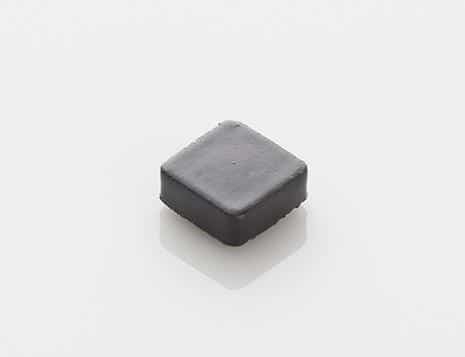source: Sumida news
Sumida has expanded its lineup of Metal Hybrid Inductors, known as the CDMT series, which is made of two kinds of metal materials. The existing type under the CDMT series is CDMT40D20 (4.3mm x 4.3mm x H 2.1mm), CDMT40D30 (4.3mm x 4.3mm x H 3.1mm) and CDMT40D40 (4.3mm x 4.3mm x H 4.1mm) are newly added as an expansion.
Along with the miniaturization trend of consumer electronics devices such as smart phones and tablet PCs, longer battery life is expected by consumers. High efficiency and low loss power circuit are needed for industrial equipments such as servers and telecommunications base stations. Sumida has developed high efficiency and low loss inductors which best suit the power supply circuits for these types of products.
Through the use of a newly developed metal composite material in the mold structure, the CDMT40D30 and CDMT40D40 have outstanding electrical performance and shielding properties, they also reflect minimum loss in performance when compared with other inductors of the same size. Thus, CDMT series including the new addition is suitable for various kinds of electronic devices.
Key Features
- Dimension:
CDMT40D30 4.3 x 4.3 x H 3.1mm (Max.)
CDMT40D40 4.3 x 4.3 x H 4.1mm (Max.) - Weight:
CDMT40D30 0.28g (Ref.)
CDMT40D40 0.37g (Ref.) - Halogen-free
- Operating temperature range: -40°C to +125°C (Not including coil’s self temperature rise)
Applications
- Telecommunication base stations, servers, SSDs, and other low profile high current applications
Main Electrical Characteristics: CDMT40D30
| Part Name | Inductance [within](µH) ※1 |
D.C.R. (mΩ) Typ. (Max.) |
Saturation Current at 20°C (A) ※2 |
Temperature Rise Currrent (A) ※3 |
|
| *4 | *5 | ||||
| CDMT40D30HF-3R3NC | 3.30 ±30% | 23.0 (25.3) | 5.0 | 4.30 | 6.60 |
| CDMT40D30HF-4R7NC | 4.70 ±30% | 37.0 (40.7) | 4.0 | 3.60 | 5.10 |
| CDMT40D30HF-6R8NC | 6.80 ±30% | 62.0 (68.2) | 3.2 | 2.70 | 3.90 |
Main Electrical Characteristics: CDMT40D40
| Part Name | Inductance [within](µH) ※1 |
D.C.R. (mΩ) Typ. (Max.) |
直流重畳許容電流で20°C (A) *2 | 温度上昇電流 (A) *3 |
|
| *4 | *5 | ||||
| CDMT40D40HF-8R2NC | 8.20 ±30% | 54.0 (59.4) | 3.20 | 2.80 | 3.40 |
| CDMT40D40HF-100NC | 10.0 ±30% | 80.0 (88.0) | 2.80 | 2.30 | 3.10 |
| CDMT40D40HF-150NC | 15.0 ±30% | 107 (118) | 2.50 | 1.95 | 2.80 |
*1 Measuring frequency at 100KHZ 0.1V
*2 Saturation current: This indicates the actual value of D.C. current when the inductance becomes 30% lower than its nominal value.
*3 Temperature rise current: The actual value of D.C. current when the temperature of coil becomes △T=40°C (Ta=20°C).
*4 Measurement condition: Irms testing was performed by a product in 25°C ambient.
*5 Measurement condition: Irms testing was performed on copper traces in 25°C ambient.
** Discharge static electricity before handling this coil. Take the static electricity measures to prevent deterioration of electric characteristics.
Production Stage
Mass Production: December 2016
































